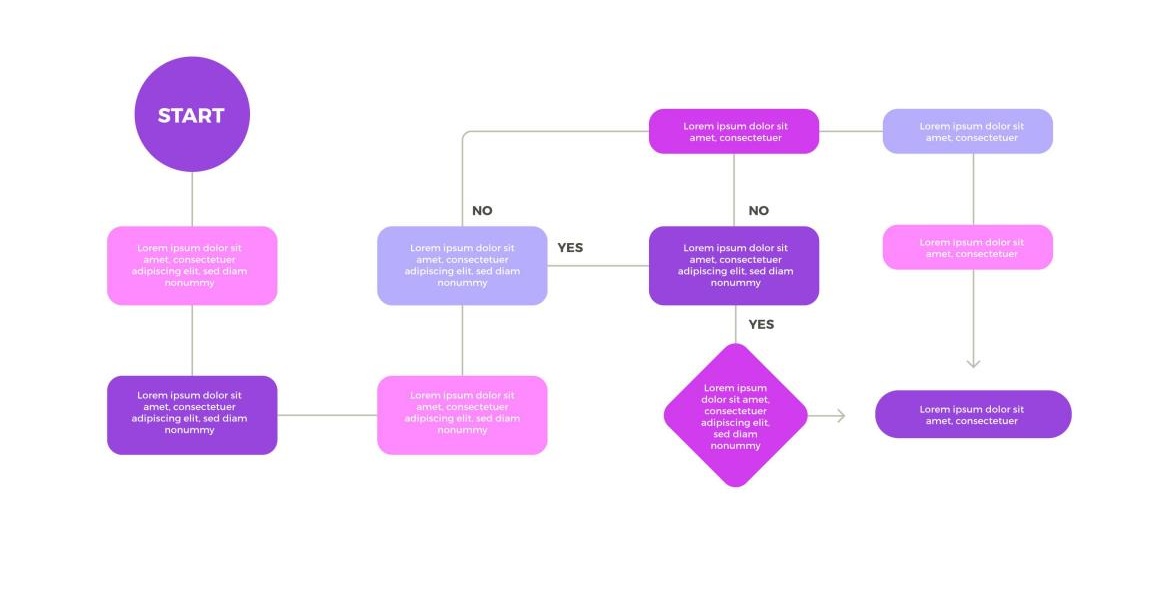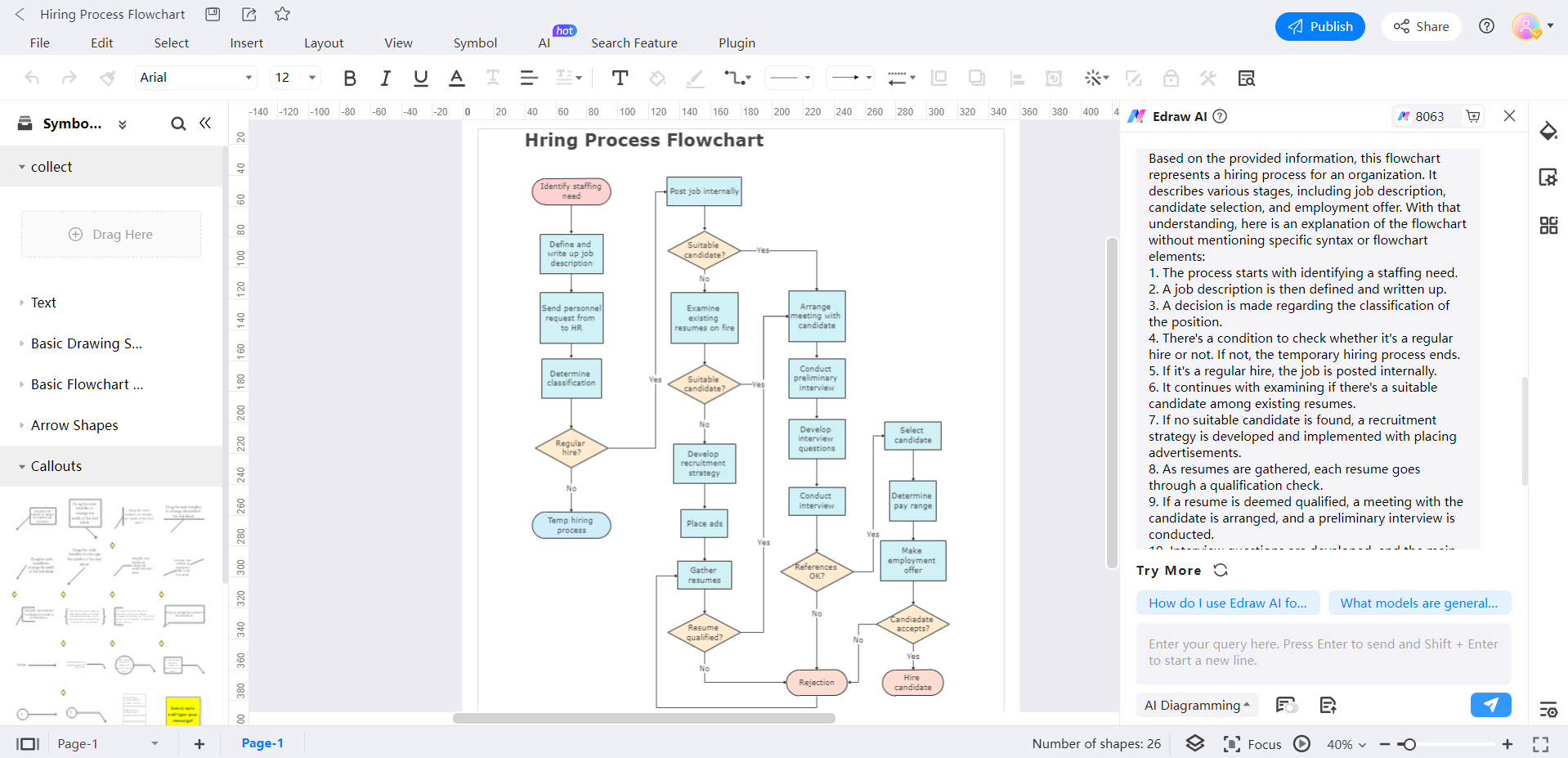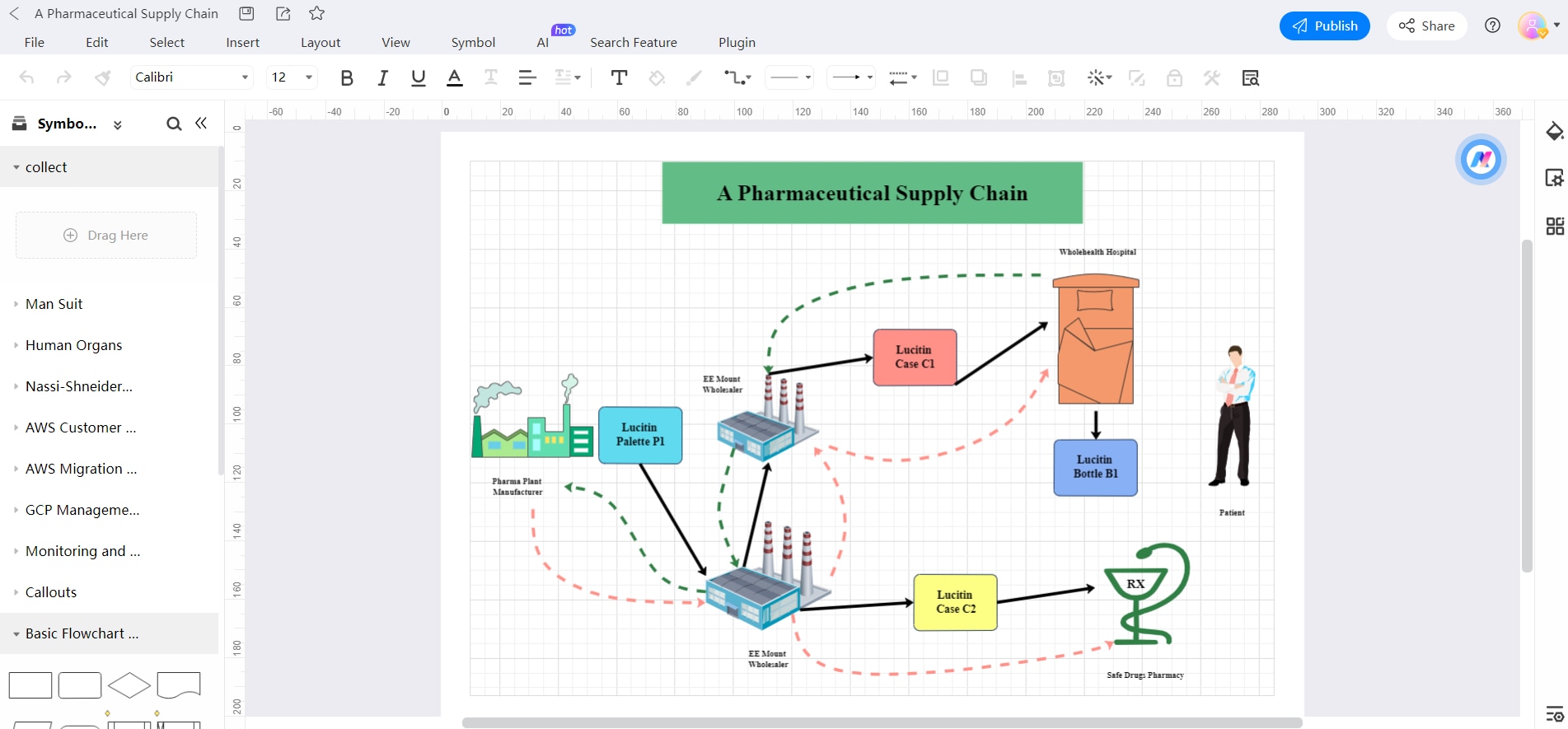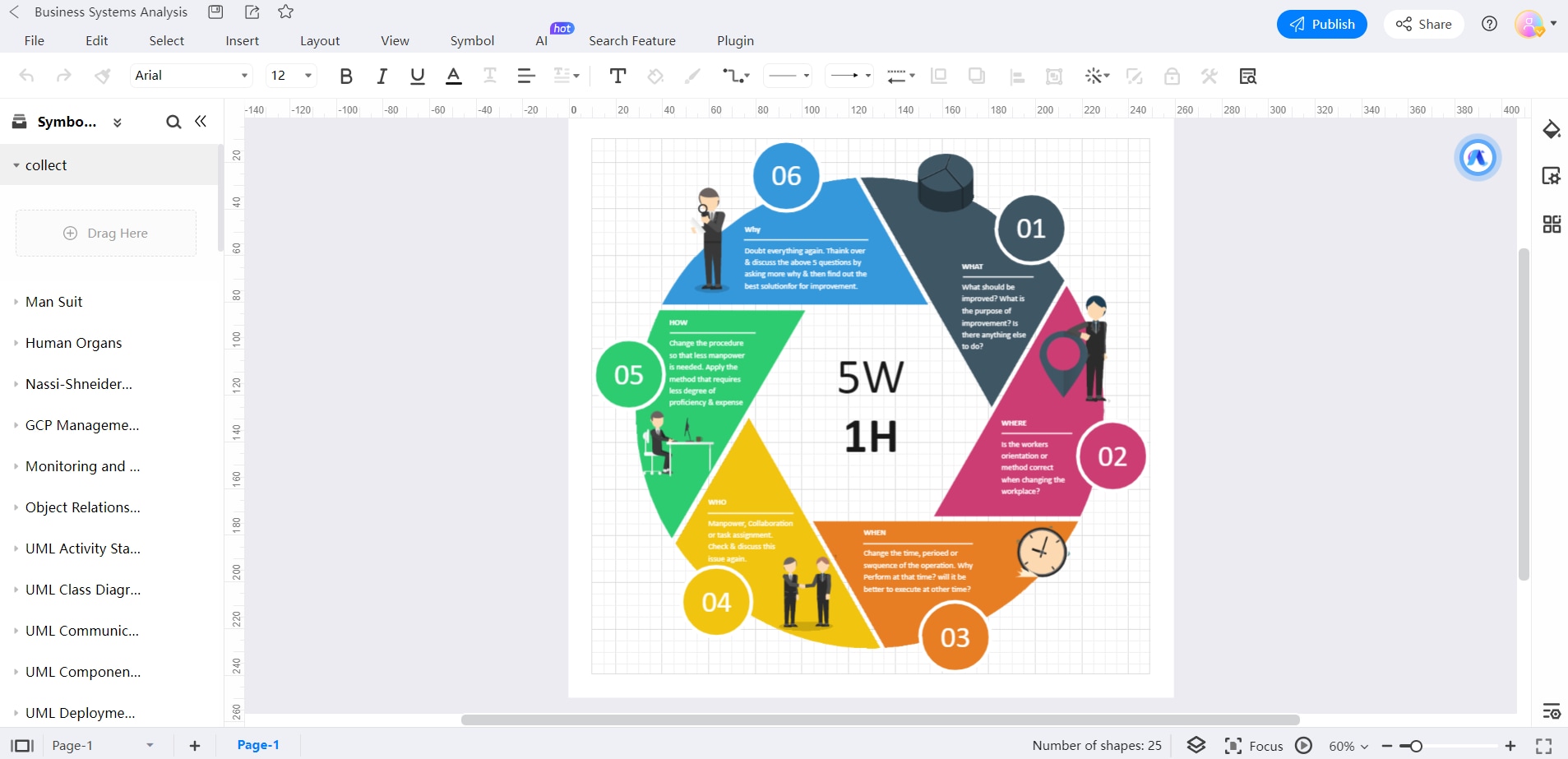Flowchart analysis is important for developing better procedures and making informed choices. However, artificial intelligence (AI) integration is changing how we approach this important work in today's era of rapid technological development.
This article explores the wide-ranging effects of artificial intelligence (AI) on data flowchart analysis, from its capacity for description to its identification and optimization capabilities and beyond.
We'll also show you EdrawMax, a powerful program that uses artificial intelligence to make flowchart analysis a breeze. AI's revolutionary power allows flowchart analysis to become more effective and insightful, improving our capacity to comprehend processes and make evidence-based decisions.

In this article
Understanding Flowchart Analysis
Flowcharts are useful in many fields because they help people understand processes and make better decisions. Traditional flowchart analysis methods, however, have difficulty scaling to larger and more complicated processes; thus, doing so efficiently is difficult. There is a risk of human error and inconsistent results when using such techniques because so much of the data must be manually entered by haa nd. Because of its rigidity, these struggle to manage forever-changing processes successfully. Fortunately, AI is the key to resolving these issues and ushering in a bright future for flowchart analysis.
AI's continued development has the potential to improve human capacity to understand intricate processes, glean useful insights, and negotiate the complexities of decision-making. Improved operational efficiency and strategic decision assistance are only two potential benefits of the recent merging of technology and flowchart evaluation.
How to Use AI to Conduct Flowchart Analysis
Flowcharts are fantastic for depicting procedures, but they shine when augmented by AI. Here, we'll look at how AI is changing the face of flowchart analysis in three major areas: description, detection, and efficiency, using EdrawMax as an illustrative example.
Flowchart Description: Enhancing Understanding and Documentation
Detailed flowchart description has traditionally been a laborious and error-prone effort to create. The descriptions that humans create are inconsistent, unclear, and incomplete. Here is when AI comes in to completely change the dynamic of play.
AI-powered products like EdrawMax use natural language processing (NLP) methods to produce descriptions for flowcharts automatically. These aren't just vague descriptions of what each flowchart section performs; you'll get a thorough justification of every decision.
For instance, Edraw AI can provide a detailed description of the hiring process flowchart below, containing the details of how the staffing process begins, how positions are classified, how resumes are checked for qualifications, and how a candidate is selected if references are accepted.

There are several advantages of using AI to create a flowchart description:
- Explanation and Clarity: The flowchart Description provided by AI is so concise that even individuals who aren't experts in the field can understand it quickly and easily.
- Productivity in Record-Keeping: Manually describing a complex flowchart, for example, might be a lengthy process. Artificial intelligence makes it much easier to record every step of a procedure.
- Consistency: With the help of AI, description will be consistent, with no room for human interpretation.
- Accuracy: You can trust that the AI-generated flowchart description includes all the necessary information.

Imagine you have developed a sophisticated flowchart outlining the steps involved in providing customer service. Each step and branching node in the flowchart can have descriptive text generated automatically using EdrawMax's AI capability. Consequently, you won't have to detail each procedure manually, and the resulting document will be easier to read and follow.
Flowchart Detection: Ensuring Consistency and Compliance
Particularly in fields where following established procedures and meeting regulatory requirements is critical, the precision of flowcharts is of utmost importance. Checking for mistakes and discrepancies the old-fashioned way takes a long time and might lead to missed mistakes.
Artificial intelligence (AI) built into software like EdrawMax provides a powerful answer to this issue. It uses pattern identification and rule-based algorithms to spot flowchart inconsistencies and mistakes mechanically. Mistakes might occur because of omitted steps, flawed decision rationale, or noncompliance.
Not only this, but it also tells you if your flowchart is perfect and needs no edits, just like it does in the below example:

The benefits of using AI to identify flowcharts are obvious:
- Correction of Errors: With AI, the probability of mistakes getting overlooked is much reduced, guaranteeing that the flowchart faithfully portrays the desired procedure.
- Time Efficiency: Examining intricate flowcharts by hand takes much time. By automating this process, AI helps save time.
- Conformity with Consistency: Artificial intelligence's capacity to detect infractions and maintain conformity with rules is especially useful in industries with stringent compliance standards.
Let’s say you have to draw a flowchart for supplying a pharmaceutical product that must meet very specific quality assurance criteria; you can use EdrawMax’s AI function.

You can automatically scan compliance concerns, such as missing quality waypoints or deviations from the permitted procedure. This speeds up the procedure and guarantees it follows all applicable laws and regulations.
Flowchart Optimization: Streamlining Processes and Identifying Improvements
Increasing productivity and streamlining operations are perennial goals for any successful business. Manual analysis, while common in conventional approaches to process optimization, can be inconsistent and time-intensive.
EdrawMax brings objectivity and effectiveness to this vital process. Using machine learning techniques, it examines flowcharts to spot inefficiencies, redundant steps, and bottlenecks.
While using Edraw AI for flowchart optimization, you get the options for possess refinement, logic exception, and adding new processes. You can select your area of optimization and get ideas.

The AI-driven benefits of optimizing flowcharts are revolutionary:
- Improvements in Productivity: When applied to business, AI can identify inefficiencies and provide solutions that boost productivity.
- Savings on Expenses: AI aids in cost reduction by pointing out areas of duplication and waste.
- Insights Derived From Data: Artificial intelligence (AI) improves decision-making by providing data-backed suggestions for optimizing processes.

For example, if you’re in charge of streamlining the business analysis process flow diagram, you can use the EdrawMax AI tool to pinpoint inefficient routing or logistical bottlenecks. It analyzes the flowchart to identify problem areas, streamlines operations, and boosts efficiency generally by suggesting data-driven enhancements to processes.
Future Trends and Considerations
Exciting artificial intelligence developments are on the horizon for the future of flowchart analysis. As technology advances, several developments on the horizon will alter how we understand and employ flowcharts.
Better AI means better flowchart analysis algorithms, which means better insights into processes, better detection of tiny inefficiencies, and more precise recommendations for process optimization.
- Integration with IoT: Flowcharts will increasingly contain real-time data from linked devices thanks to the Internet of Things (IoT).
- Augmented Reality (AR) Interfaces: When augmented reality (AR) combines with flowcharts, it will provide users with intuitive comprehension and troubleshooting by allowing them to engage with and explore procedures throughout three dimensions.
Thinking about ethical and practical issues as we adopt innovations is important. Although AI is effective, it does have certain restrictions. Using AI for flowchart analysis can be incredibly useful, but only if we strike the right balance between creativity and accountability.
The Application of AI in Flowchart Generation
Artificial intelligence (AI) has ushered in a new era of ease, efficiency, and accessibility in flowchart generation. EdrawMax is just one example of how artificial intelligence (AI) is transforming this industry by making formerly tedious tasks incredibly simple and quick.
There are several compelling benefits of using AI to generate flowcharts:
- Friendly User Experience: The user interfaces of AI-powered flowcharting tools are as straightforward as possible. Because of this, people with diverse degrees of technical ability can now build complex flowcharts easily.
- Effectiveness and Swiftness: Making flowcharts the old-fashioned way, by hand, can be tedious and prone to mistakes. Artificial intelligence speeds up this procedure by automating the layout and organization of parts so that people can concentrate on the actual information rather than the presentation.
- Managing Complexity: Complex flowcharts do not match AI's ability to create them. It saves customers the trouble of manually positioning and aligning complex decision trees, loops, and related processes.
- Consistency: Artificial intelligence (AI) guarantees that flowcharts are uniform in style and formatting, giving all diagrams a polished appearance.
Conclusion
AI is drastically altering the landscape of flowchart analysis. EdrawMax's use of state-of-the-art AI technologies provides a glimpse into the future of flowchart design, analysis, and improvement. The potential for increased productivity and more informed policymaking is too great to ignore the current wave of technological advancement.
Envision a scenario where AI has made it possible to quickly and easily draw, analyze, and optimize flowcharts. The use of AI in EdrawMax makes this dream a practical one.
There is a way for you to enhance processes and make smarter choices!




